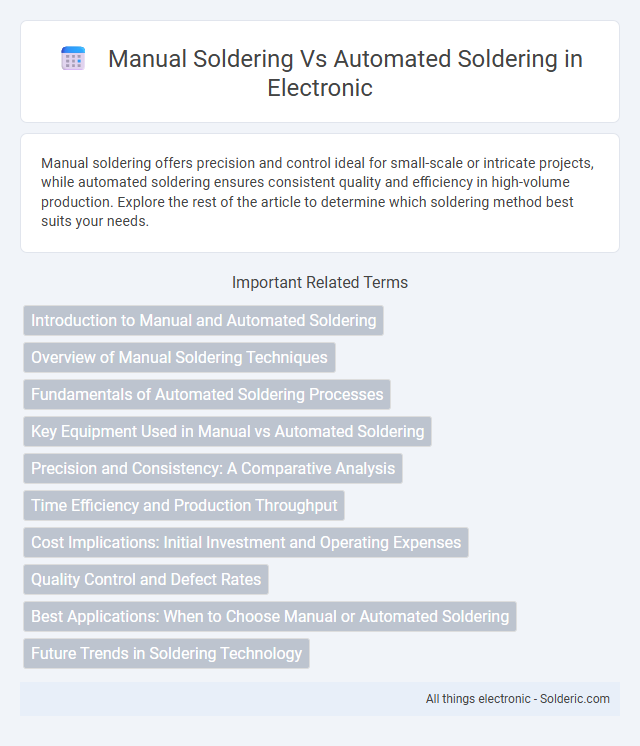Manual soldering offers precision and control ideal for small-scale or intricate projects, while automated soldering ensures consistent quality and efficiency in high-volume production. Explore the rest of the article to determine which soldering method best suits your needs.
Comparison Table
| Feature | Manual Soldering | Automated Soldering |
|---|---|---|
| Precision | Moderate, depends on operator skill | High, consistent and repeatable |
| Speed | Slower, limited by human pace | Faster, continuous operation |
| Cost | Lower initial investment | Higher initial equipment cost |
| Scalability | Limited for high volume production | Ideal for mass production |
| Quality Control | Variable, depends on operator experience | Consistent, programmable parameters |
| Flexibility | High, easy to adapt to varied tasks | Lower, best for repetitive tasks |
| Training | Requires skilled operators | Requires programming and maintenance expertise |
| Applications | Prototyping, small batch production, repairs | High volume manufacturing, automotive, electronics |
Introduction to Manual and Automated Soldering
Manual soldering involves skilled technicians using handheld tools to precisely join electronic components, allowing flexibility in complex or low-volume projects. Automated soldering employs machines like wave or reflow soldering systems to consistently produce high-quality joints at scale, ideal for mass production. Choosing between methods depends on factors such as production volume, component density, and quality control requirements.
Overview of Manual Soldering Techniques
Manual soldering techniques involve using handheld tools like soldering irons or guns to join electronic components by melting solder wire precisely at the joint. This method offers high flexibility and control, making it ideal for prototype development, small-scale production, and intricate repairs. Understanding your manual soldering technique ensures strong, reliable connections and minimizes damage to sensitive components.
Fundamentals of Automated Soldering Processes
Automated soldering processes utilize precision robotics and controlled heat application to achieve consistent, high-quality solder joints, optimizing throughput in electronics manufacturing. These systems rely on methods such as wave soldering, reflow soldering, and selective soldering, where programmable parameters ensure accuracy and repeatability. Understanding the fundamentals of automated soldering enables you to select the best process for your production needs, balancing efficiency with product reliability.
Key Equipment Used in Manual vs Automated Soldering
Manual soldering primarily relies on handheld soldering irons, solder wire, flux, and basic tools like tweezers and magnifiers to ensure precision. Automated soldering employs advanced machinery such as wave soldering machines, reflow ovens, and robotic soldering systems designed for high-speed and consistent solder joints. Your choice between manual and automated soldering depends on factors like production volume, precision requirements, and equipment investment.
Precision and Consistency: A Comparative Analysis
Manual soldering offers greater flexibility for intricate or custom tasks but often lacks the precision and consistency of automated soldering systems, which utilize precise temperature controls and repeatable motion to ensure uniform solder joints. Automated soldering delivers high reproducibility, minimizing human error and variations in solder quality, making it ideal for large-scale production with strict quality standards. Your choice should consider the trade-off between the adaptability of manual techniques and the unparalleled consistency provided by automated processes.
Time Efficiency and Production Throughput
Manual soldering requires skilled technicians and is time-intensive, limiting production throughput due to slower process speed and higher variability. Automated soldering systems significantly increase time efficiency by enabling rapid, consistent solder joints, supporting high-volume production runs with minimal errors. Optimized automation reduces cycle times and enhances overall manufacturing productivity, meeting demanding industrial throughput requirements.
Cost Implications: Initial Investment and Operating Expenses
Manual soldering requires lower initial investment costs as it primarily involves basic tools and skilled labor, making it more accessible for small-scale or prototype production. Automated soldering demands a significantly higher upfront expenditure due to the purchase of specialized machinery and programming, but offers reduced operating expenses over time by minimizing labor costs and increasing throughput. Evaluating cost implications involves balancing initial capital outlay against long-term operational efficiency and production volume requirements.
Quality Control and Defect Rates
Manual soldering allows for precise control in complex or delicate tasks, but its quality heavily depends on operator skill, often resulting in higher defect rates and inconsistent quality. Automated soldering offers consistent, repeatable quality by minimizing human error, significantly reducing defect rates through controlled temperature profiles and precise solder application. Advanced vision systems and real-time monitoring in automated processes enhance quality control by detecting defects early, ensuring higher overall reliability.
Best Applications: When to Choose Manual or Automated Soldering
Manual soldering is best suited for prototyping, small-scale production, or repairing complex, delicate components where precision and human judgment are critical. Automated soldering excels in high-volume manufacturing environments, ensuring consistent quality, higher throughput, and reduced labor costs for repetitive tasks. Selecting between manual and automated soldering depends on production scale, component complexity, and desired consistency in solder joints.
Future Trends in Soldering Technology
Future trends in soldering technology emphasize advanced automation, integrating AI and machine learning to enhance precision and reduce defects in both manual and automated soldering processes. Automation is increasingly favored for its ability to scale production and maintain consistent quality in electronics manufacturing, while manual soldering evolves with ergonomic tools and real-time feedback systems to improve accuracy. Your choice between manual and automated soldering will depend on the complexity of the task and the demand for efficiency, as emerging hybrid systems blend human skill with robotic assistance for optimal results.
Manual soldering vs automated soldering Infographic

 solderic.com
solderic.com